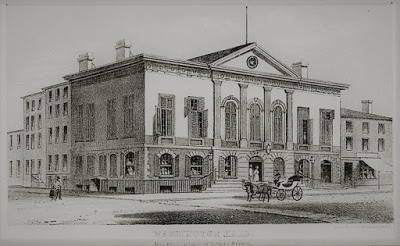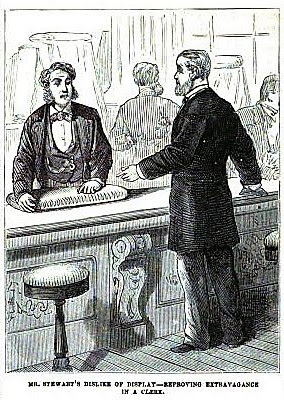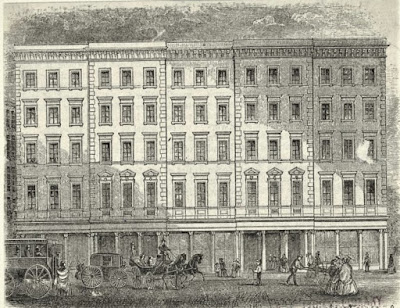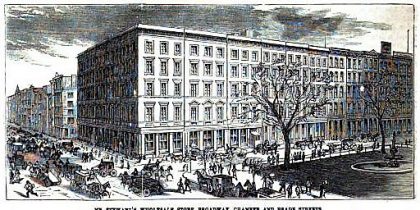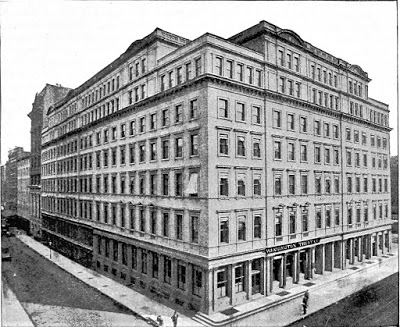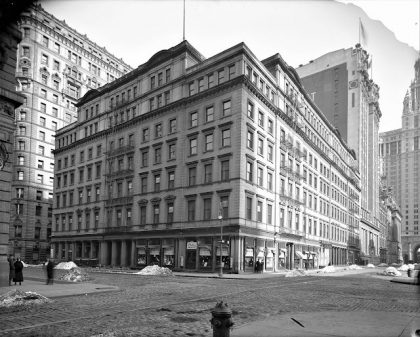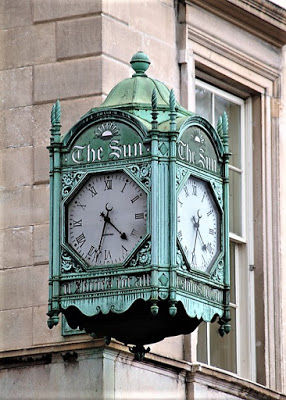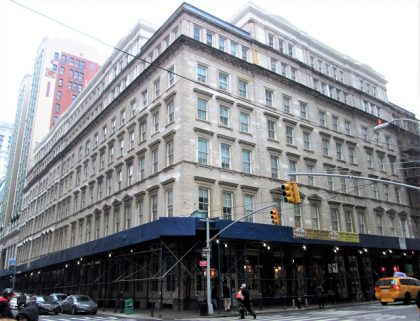The History of 280 Broadway – The Sun Building
 Tom Miller, who writes about the history of Manhattan buildings at Daytonian in Manhattan, has allowed Tribeca Citizen to create a database of his Tribeca posts. If you enjoy these, and you will, then you should definitely check out his website, which also has write-ups about buildings all over the island. And don’t miss his book, Seeking New York: The Stories Behind the Historic Architecture of Manhattan—One Building at a Time.
Tom Miller, who writes about the history of Manhattan buildings at Daytonian in Manhattan, has allowed Tribeca Citizen to create a database of his Tribeca posts. If you enjoy these, and you will, then you should definitely check out his website, which also has write-ups about buildings all over the island. And don’t miss his book, Seeking New York: The Stories Behind the Historic Architecture of Manhattan—One Building at a Time.
··································
Alexander Turney Stewart started business in 1823 with a small lace and linens shop in half a store in a little wooden building at No. 283 Broadway, between Church and Reade Streets. He had a sleeping room in the rear. The Irish immigrant possessed a genius for marketing–he came up with the concept of a department store, recognized the value of customer service rather than overcharging the buyer, and would later develop the idea of mail order business.
In his 1884 History of New York City, Benson J. Lossing wrote “Mr. Stewart, by great commercial sagacity and operating upon a cash basis, had accumulated a fortune sufficient to enable him to purchase Washington Hall, which had been used for many years as a hotel.”
Stewart paid $70,000 for the property–about $2.73 million today. On the site, directly opposite the spot where he started out, he would erect “a magnificent marble structure” which Lossing called “the pioneer of marble, freestone, and iron stores on Broadway.” Designed by Joseph Trench and John B. Snook, it was also the first commercial building in the Italianate style.
The glistening white marble upper floors sat upon a storefront with Corinthian columns and expanses of plate glass show windows. The tireless diarist and former mayor Philip Hone visited the store a few weeks before its completion. “Mr. Stewart’s splendid edifice, erected on the site of Washington Hall…is nearly finished, and his stock of dry goods will be exhibited on the shelves in a few days. There is nothing in London or Paris to compare with this dry goods palace.” His sole problem was the plate glass show windows which he called a “useless piece of extravagance.” (He envisioned a boy’s snowball producing disaster.)
The new emporium opened on September 21, 1846. It quickly gained the popular moniker The Marble Palace, no doubt because of The Evening Post’s describing, “the looming front of a marble palace, five stories high, decorated in the most beautiful style of art.” The newspaper added that “an incessant current of carriages may be seen approaching and leaving and as upon Jacob’s ladder an unbroken file of angels, ascending and descending its marble steps.”
The New York Herald reported “When we visited the store about 12 o’clock, we found a line of carriages drawn up in front reaching from Chambers to Reade streets. Crowds of fashionable people were passing in and out, and all were warm in their expressions of gratification of all the beautiful and tasteful arrangements and architecture of the this whole building.”
Well-dressed women entered into a rotunda decorated with wall and ceiling frescoes and dominated by a glass dome 80 feet above the floor, 70-feet in circumference. An ornate chandelier, expansive mirrors imported from Paris and a graceful flight of stairs elevated the store above anything shoppers had seen before.
Visiting A. T. Stewart’s was as much a social activity as a shopping event. A gallery encircled the rotunda for promenading–the popular Victorian ritual of seeing and being seen. The Continental Monthly commented that the name Stewart evoked “a train of ideas, a marble front, plate glass, gorgeous drapery, legions of clerks, paradise of fashion, crowds of customers, and all the fascination of a day of shopping.”
Tremendous success necessitated enlargements. Additions were made in 1850-1851 and again the following year, both designed by Trench & Snook. The enlargements doubled the size of the original building. In 1853 A. T. Stewart’s did $7 million in business.
The unrelenting northern movement of commerce prompted Stewart to erect an even larger retail store in 1862, engulfing the entire block of Broadway between East 9th and 10th Streets. No. 280 Broadway now held the firm’s wholesale store and its clothing manufacturing shops. The building was enlarged again in 1872 by architect Frederick Schmidt.
Alexander T. Stewart died on April 10, 1876. Judge Henry Hilton, one of the executors of the Stewart estate, took control of the real estate. Two years later, in November, The Carpet Trade Review reported “The down-town marble building on the corner of Broadway, Chambers and Reade Streets…is soon to be vacated.” The departments still housed in the building were moving north to the Broadway and 10th Street store. Hilton let No. 280 remain vacant until 1884, when he added two floors, expanded along Chambers and Reade Streets, and converted the interior to offices.
In April 1885 The Presbyterian Home Missionary announced “After the first of May next our friends will please find us or address us at Stewart’s Building, 280 Broadway.” The once-elegant retail palace saw a mish-mash of businesses for the next few years. By 1888, however, the majority of the tenants were attorneys and legal firms. In the 1890’s the city moved several its departments in. On February 19, 1896 The New York Times reported that the city was paying a total of $95,540 per year in rent here–in the neighborhood of $2.88 million today.
When war broke out in Europe, offices in No. 280 Broadway became home to the Army Recruiting Headquarters. On June 6, 1917 it got a somewhat surprising neighbor. The New York Times reported “On the first floor of 280 Broadway, separated only by a few doors from the headquarters of the United States Army recruiting in the city, the British Recruiting Mission began…to enlist British subjects for service with their own colors”
That same year Frank A. Munsey, owner of the New York Herald and The Evening Sun purchased the building. The New York Times reported that he paid $4 million for the property. In 1919, after significant interior renovations were made, he moved the newspapers’ operations in.
The first threat to the marble structure came when Munsey announced in June 1922 his intentions “as soon as the cost of building materials and labor are reduced…to replace the building with a thoroughly modern structure.” Apparently those costs never came down to Munsey’s liking and the building, by now known popularly as the Sun Building, survived.
On June 13, 1927 America’s hero, Charles “Lucky Lindy” Lindbergh was honored with a ticker-tape parade on Broadway to celebrate his solo flight across the Atlantic Ocean in the Spirit of St. Louis. The festivities did not end there, of course. On June 17 The New York Times reported “A brief interlude in Colonel Lindbergh’s morning of automobiling yesterday was spent in the office of The Sun, 280 Broadway. There he received a silver plaque bearing the editorial ‘Lindbergh Flies Alone.'” It was the headline which The Sun’s readers had awoken to on May 21.
Surprisingly, when Frank A. Munsey died, he left the Sun Building to the Metropolitan Museum of Art. On January 2, 1928 the newspaper purchased the it from the museum. In reporting the sale The Times reminded readers that “The property was largely reconstructed and thoroughly modernized when Mr. Munsey took it over for his newspapers.”
With the onslaught of the Great Depression, The Sun management took steps to help the economy. In September 1933 it announced it had placed a $500,000 order for 24 new printing presses. The statement explained that the order was made “as a contribution not merely to the improvement of its own plant but also to the success of the re-employment and buy-now campaigns of the National Recovery Administration.”
The Sun got an unlikely bedfellow when The Times of London opened its offices on the top floor. A near riot broke out on June 8, 1939 when when the newspaper printed coverage of “the first visit of a reigning British monarch and his Queen to these former-British colonies,” as described by The New York Times.
The 13,000 copies distributed to newsstands sold out by 9:00 in the morning. The newspaper then sent out the 2,400 copies held back for mail requests, but those too, sold out quickly. The Times reported “Then near pandemonium set in on the seventh floor of the Sun Building, 280 Broadway, where the London paper has its offices. Hundreds of would-be customers were turned away.” Copies that normally sold for 5 cents were bringing $1 on the streets, “with plenty of takers.” The Times of London had to disconnect its telephones in order so that the staff could work.
Following the end of World War II Henry Modell, owner of the sporting goods chain, established the Modell Veteran Training Center in a retail space. Mayor William O’Dwyer officially opened the facility on March 23, 1946. The dual-purpose establishment both trained wounded and handicapped veterans for private life and sold surplus war supplies.
By 1949 the training center had been phased out, replaced by a Modell’s store. It was at the Broadway location that the mayor cut the cake to celebrate the chain’s 60th anniversary.
The following year The Sun merged with The World-Telegram. Management spokesmen informed the press that the merger “included only The Sun’s name, good-will and circulation lists.” In other words, it was essentially the end of the Sun’s operation. And nearly the end of the Sun Building.
The property was purchased by a syndicate headed by Charles F. Noyes. On January 26, 1951 it announced that a skyscraper would be erected on the site. The New York Times reported “The new building will be about forty stories tall and will contain 1,000,000 square feet of space.”
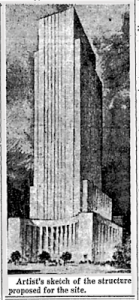
But, once again, the venerable structure survived. In the fall of 1959 Modell’s began a modernization of its storefront which dismayed at least one journalist. The New York Times reported on October 3 “The facade of the Stewart Building at 280 Broadway, at Chambers Street, a landmark for 112 years will soon become a memory. Workmen have begun removing the stone colonnades that will be replaced by a wide expanse of contemporary aluminum and glass panels.”
In 1966 the city took possession of the building after it and the historic Tweed Courthouse next door were condemned for a 52-story tower designed by Edward Durell Stone. That project stalled but, as Municipal Services Administrator John T. Carroll explained on April 22, 1975 it “is not legally buried.” Therefore the city decided “not to invest any funds in rehabilitation 280 Broadway” although city offices had been moved in.
The decision led to shameful consequences. On August 5, 1981 The New York Times columnist Michael Goodwin wrote “The white marble facade still gleams in the sun and the cast-iron columns above the street recall a grand past, but, inside, 280 Broadway is full of the signs of a grim present.”
Plaster fell from the ceilings of the halls, window frames were on the verge of falling out, and large cracks appeared in the walls. After rainfalls, ceiling tiles would be found on the floor. An administrator in one department pointed out a partitioned-off area in an office. “The building workers told us not to use this part of the room because it’s so dangerous.”
Any chance of demolition was squelched in October 1986 when the No. 280 Broadway was designated a New York City landmark. Protection of the structure did not mean improvement of the interior conditions, however. In February 1994 the newly-appointed Commissioner of General Services, William J. Diamond, visited the building. The word he used to described it was “atrocious.”
Referring to the landmark designation he told The New York Times architecture journalist David W. Dunlap, it was “saved but saved for what? You’re essentially in an office slum.” He suggested selling the building to a private developer for renovation and restoration, pointing out that the still-intact rotunda “could be turned into a food court.”
Ideas like his were bounced around for three years before a $37.2 million renovation was initiated. Completed in 1999 it now housed the city offices like the Department of Buildings. The renovations, designed by the architectural firm of Beyer Blinder Bell, resulted in retail space on the ground floor and offices above. The rotunda, now called an atrium, included five skylights above the central court.







